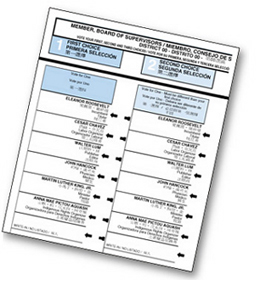| |
|||||
|
Mixed results for ranked-choice voting, SFSU finds | ||||
|
December 16, 2004 |
|||||
 About
three in five (61 percent) San Francisco voters said they preferred the
city's new ranked-choice voting system that debuted in last month's district
supervisor elections, according to preliminary results of a survey conducted
by SFSU. Thirteen percent said they preferred the former runoff system. About
three in five (61 percent) San Francisco voters said they preferred the
city's new ranked-choice voting system that debuted in last month's district
supervisor elections, according to preliminary results of a survey conducted
by SFSU. Thirteen percent said they preferred the former runoff system.
"While the majority of voters surveyed said they knew about ranked-choice voting, understood it and used it to rank three preferences, differences were found among types of voters," said assistant professor of political science Francis Neely, who conducted the survey with Corey Cook, assistant professor of political science, and Lisel Blash, senior researcher for the SFSU Public Research Institute. "Non-Hispanic whites and Asian Americans reported having more prior knowledge and understanding than other racial and ethnic groups, and were more likely to say they ranked three candidates. Income, education and one's first language also explained differences in voters' experience with the ballot." More than two-thirds (69 percent) of voters surveyed knew that they would be asked to rank their choices for the Board of Supervisors, while 31 percent were unaware before voting. Younger voters, those with Spanish as a first language, African Americans, Latinos, those with a high school degree or less, and those with low-incomes were less aware that they would be asked to rank candidates on the ballot. Overall, 52 percent of those surveyed said they understood ranked-choice voting "perfectly well"; 35 percent said they understood it "fairly well." About 11 percent said they "did not understand it entirely," and another 3 percent said they "did not understand it at all." Preliminary results indicate that African Americans (23 percent), Latinos (19 percent), and voters of "other" racial/ethnic groups (17 percent) were more likely to report a lack of understanding than Asian (13 percent) or white (12 percent) voters. Voters with lower levels of education and income, and those whose first language is not English or Chinese also reported less understanding. The exit-poll survey was funded by the city and county of San Francisco and SFSU College of Behavioral and Social Sciences and prepared by the Public Research Institute. It was conducted to gauge the ease or difficulty with which voters expressed their preferences on the new form of ballot. The survey included a sample of 2,847 voters from city supervisor districts 1, 2, 3, 5, 7, 9 and 11. More than 100 student volunteers interviewed the respondents at polling places. Ranked-choice voting eliminates the need for a separate run-off election. Voters elect local officials by selecting a first-choice candidate in the first column on the ballot, and different second- and third-choice candidates in the second and third columns on the ballot. The system was implemented in November following the passage of a San Francisco ballot initiative in 2002. San Francisco is the largest city in the nation to employ ranked-choice voting, and other cities are monitoring the system's success to help them determine whether to pursue it. A full report will be issued in late January. It will include results from additional exit-poll data and an absentee voter survey. -- Matt Itelson
|
|||||
 |
1600 Holloway Avenue, San Francisco, CA 94132 (415) 338-1111 |